If you are looking for a ConvertKit Discount, then you’ve come to the right place! In this article, I’ll share how you can get the maximum discount on the ConvertKit.
ConvertKit is one of the fastest-growing email marketing tools of all time! It’s mainly marketed towards bloggers, and online creators like podcasters, YouTubers, online courses creators as it’s the perfect balance of usability combined with features and automation.
Click Here To Try ConvertKit For FREE
ConvertKit Discount Code: Auto Applied
ConvertKit Discount Code
It’s no wonder online marketing professionals like Pat Fylnn (from SmartPassiveIncome.com) have switched their email lists over in the past few years.
With the easiest to use visual interface, ConvertKit if honestly a no-brainer for a blogger in 2020.
Starting at $29/month for up to 1000 subscribers, ConvertKit is definitely value for the money for all the advanced features you get.
If you pay Annually for ConvertKit ie 12 years at a time, you can 2 months for free. That’s about 17% discount!
If you’re creating a new account you can directly pay for the 12 months and start using ConvertKit by clicking here.
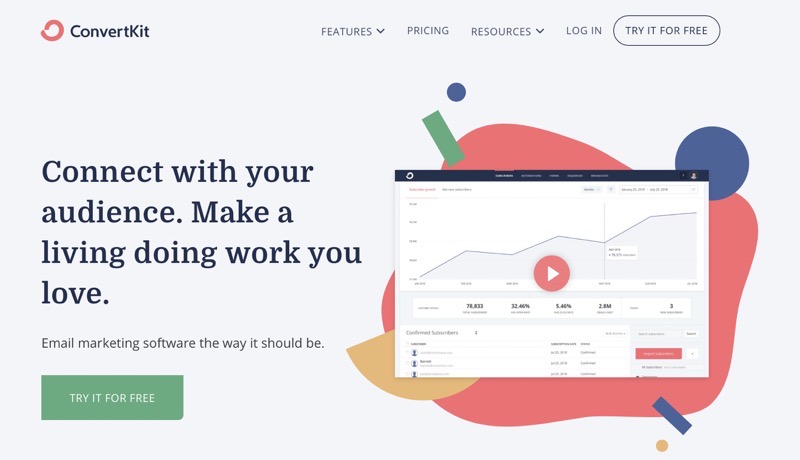
ConvertKit Coupon Code
They’re many websites on the internet making misleading offers such as:
- ConvertKit Coupon
- ConvertKit Discount Coupon
- ConvertKit Discount Code
- ConvertKit Discount
- ConvertKit Coupon Code
- ConvertKit Coupons
- ConvertKit Code
- ConvertKit Promo Codes
- ConvertKit Promo Code
- ConvertKit Vocher
However, the truth is that ConvertKit does not offer any coupons!
You can get a discount on ConvertKit if you decide to pay Annually instead of Monthly! If you decide to pay yearly instead of monthly you will save 17%
Click Here To Try ConvertKit For FREE
ConvertKit Discount Code: Auto Applied
ConvertKit Free Trial
If you click on this link you can get a free trial of ConvertKit! This a great opportunity to give ConvertKit a whirl without having to commit. You’re limited to 1000 subscribers.
ConvertKit Pricing
ConvertKit is available in 4 different pricing plans based on the size of the list:
- Up to 1k subscribers: $29/month
- Up to 3k subscribers: $49/month
- Up to 5k subscribers: $79/month
- Bigger Lists: Depends on size
All plans have all ConvertKit features. The highest plan >5000 subscribers have a free add-on of “Free concierge migration”
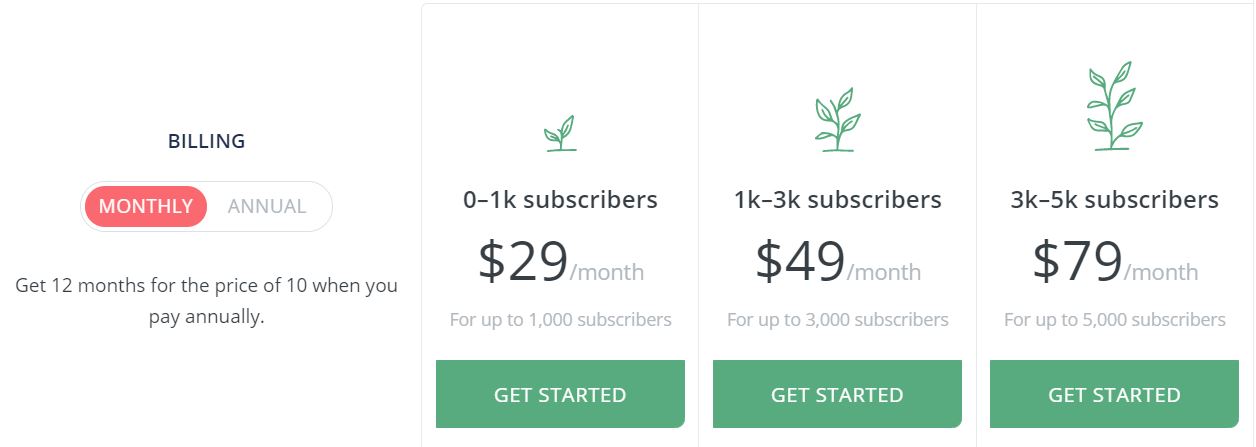
If you run you number you might think that ConvertKit is more expensive than Aweber or Mailchimp, though ConvertKit is more expensive at face value, many people actually save money when they make the switch.
Here’s how: MailChimp and Aweber charge you for duplicate subscribers & Aweber also charges you for people who’ve unsubscribed. ConvertKit is actually quite a bit cheaper. And you get the wonderful benefits of using tags instead of multiple lists which means you don’t ever have to worry about duplicate subscribers.
ConvertKit Freeium Plan
ConvertKit went Freemium in 2020 and launched a free plan for landing page!
What’s included in the ConvertKit Freeium Plan?
- Unlimited landing pages or opt-in forms to start growing your audience
- To send email, you can either upgrade to a paid account for $29/month OR if you invite a friend through our referral program you’ll unlock subscriber management (tags, segments, and more!) and the ability to send broadcast emails for up to 100 subscribers.
- For every invite accepted you unlock another 100 subscribers!
- Once you upgrade to a paid account you will get all the automation features and you keep the additional subscribers you got from your invites.
Click Here To Try ConvertKit For FREE
ConvertKit Discount Code: Auto Applied
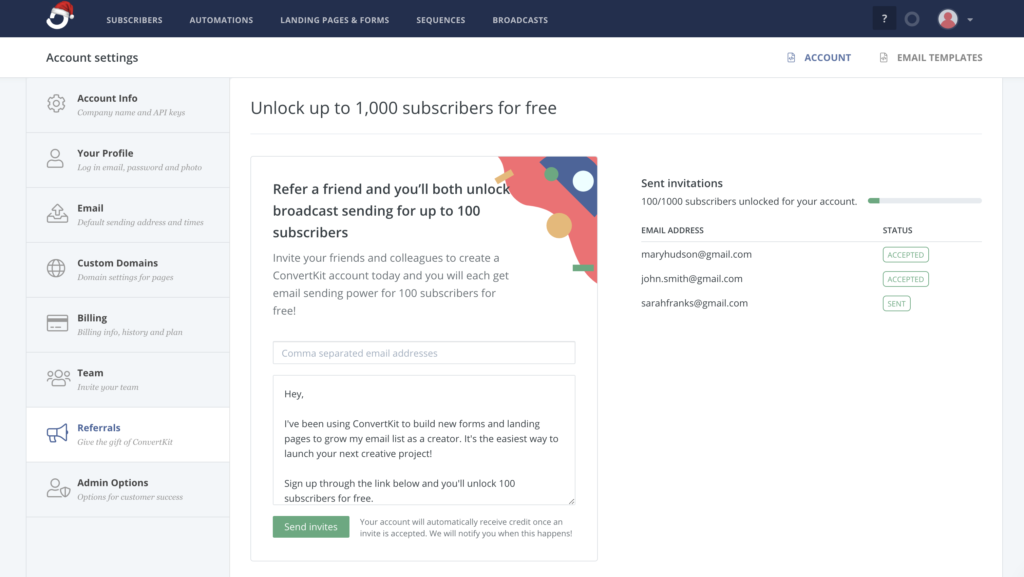
ConvertKit Annual Discount
If you pay Annually for ConvertKit ie 12 years at a time, you can 2 months for free. That’s about 17% discount!
If you’re creating a new account (and not signing up for the free trial) you can directly pay for the 12 months and start using ConvertKit by clicking here.
However, if you are on the free trial and you decide that you want to continue using the tool, contact the amazing ConvertKit support and they’ll upgrade you to an annual plan and get you that discount.
How To Get the ConverKit Discount
If you already have an email list and it’s over 1000 subscribers you get two months of ConvertKit for free by click this link to go to the ConvertKit website and then click on the Yearly Billing button on the pricing page.
Click Here To Try ConvertKit For FREE
ConvertKit Discount Code: Auto Applied
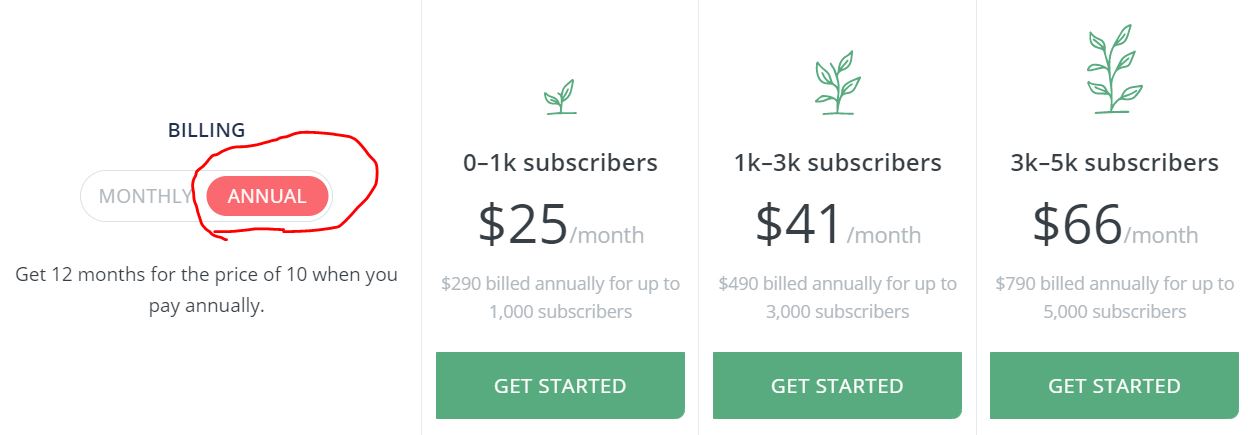
ConvertKit Review
Email marketing is one of the most important parts of any digital marketing strategy. While it might not be the trendiest topic these days, it still remains as one of the best ways to connect with your potential customers on a highly personal level.
When it comes to ROI, email marketing is right at the top. According to studies, email marketing generates about $38 for every $1 spent on average and emails also usually have a much longer lifespan than social media posts do.
There are a number of established email marketing tools available today with MailChimp, ActiveCampaign, and Aweber being some of the most widely used ones.
However, in this review, we’re going to take a look at ConvertKit.
ConvertKit hit 27,000 active users at the end of 2019.
That’s quite a lot considering that ConvertKit launched in 2013.
Every professional blogger from Pat Flynn to the solo digital marketer uses ConvertKit.
BUT…
Is ConvertKit actually worth it? or just hyped by Digital marketers & “how to make money online” bloggers?
Well, I’ve personally worked with email lists of all sizes, from running a tiny email list for a niche site to being behind the scenes of companies with millions of emails on their list.
By the end of the ConvertKit review, I hope to explain why ConvertKit despite being a relatively new email marketing tool that has positioned itself as one of the best email marketing tools in recent years, especially for content creators.
Click Here To Try ConvertKit For FREE
ConvertKit Discount Code: Auto Applied
ConvertKit is built for creators ie. Bloggers, YouTubers, course creator, podcasters and if you a “creator” it’s honestly the best service for email marketing if you run a blog or any kind of content business! It’s super easy to use interface makes it easy to launch a marketing campaign.
In terms of UI, ConvertKit one of the easiest to use and makes it super easy to organize your email marketing campaigns.
When you get started with email marketing it can be a little overwhelming with all the tools and autoresponders.
So what do most bloggers end up doing?
If you ask 1000 bloggers who’ll find that 90% of then will either sign up for MailChimp (which is terrible and not worth it) or just not build an email list.
Why is that?
Because most email marketing tools are super complicated and doesn’t really make it easy for a non-techie person to run email marketing effectively!
This is why I love ConvertKit, its easy to use and someone who doesn’t want to fiddle with all the plugins, api and other tools can just LAUNCH!
Click Here To Try ConvertKit For FREE
ConvertKit Discount Code: Auto Applied
About ConvertKit
ConvertKit was created by Nathan Barry in 2013. It was built specifically for creators, like bloggers and podcasters, with the intention of helping them grow their email lists and eventually increase their online sales.
It is a fully-fledged email marketing tool that comes with impressive features that can be used to turn potential prospects into followers, subscribers, and customers. With simplicity being a core fundamental part of its philosophy, ConvertKit is an email marketing tool that almost anybody can learn to use quickly.
There are a number of things about ConvertKit that I really like such as the landing pages, the simple tagging system, autoresponders, embedded forms, and more that are covered below in this in-depth review.
TL;DR – If you’re a content creator in 2020 and want to step up your email marketing strategy, ConvertKit might be one of the best tools for you.
Click Here To Try ConvertKit For FREE
ConvertKit Discount Code: Auto Applied
Reasons I ❤️ ConvertKit
One of the main reasons I and many other bloggers recommend and use ConvertKit is because it’s super easy to use however it doesn’t sacrifice great features and automation in the process. It’s honestly exactly in the goldilocks area 😉
1. Easy List Management
ConvertKit makes it super easy to manage your subscribers as you don’t have 10s of 100s of lists as you might in tools like Aweber or MailChimp. Everything is in one single list as ConvertKit is based on a the subscriber and you manage your list using simple to use tags.
2. Open Startup
ConvertKit as a company is one of the most open and public about everything they do. In fact, you can see their minute to minute revenue and business metrics data by clicking here. Not only are they open about how much they make, but they’re also very active in the online marketing space.
3. High Converting Out-Of-Box
ConvertKit is built with Conversions in mind especially as a lot of online marketing professionals use it (and we are a snobby bunch of people who want things to very focused on conversions). They have beautifully designed Opt-In-boxes and popups that make it super easy to get started and collect leads.

4. High Converting Landing Pages
With ConvertKit you don’t necessarily have to invest in a secondary landing page builder like Leadpages or Unbounce as you can build beautiful landing pages in ConvertKit. You get a ton of pre-built conversion-focused templates that you can import and modify to fit your needs.
PS: ConvertKit recently launched a free plan just for the landing pages! How cool is that?
Click Here To Try ConvertKit For FREE
ConvertKit Discount Code: Auto Applied
5. Simple Analytics
It’s easy to get bogged down with all the data that many email marketing tool that you never execute on anything. ConvertKit keeps things simple and only gives you the basic data that matters like a subscriber chart over time to get an overview of your business.
6. Integrations
It doesn’t matter what tool or service you use, ConvertKit integrates with it either Natively or thought third-party tools like Zapier. It even has native support for Shopify which is a big plus making it a great MailChimp alternative.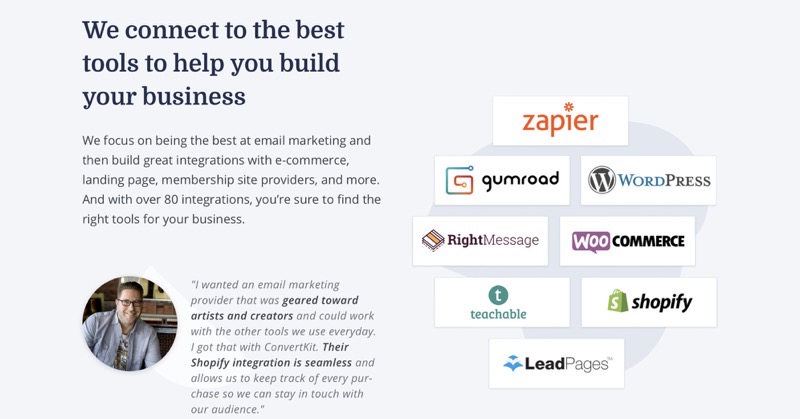

7. Automation
The visual automation on ConvertKit is super easy to use and makes it super easy to create and visualize every marketing campaign. It’s pretty convenient even for someone who hasn’t ever done a marketing campaign before.
8. Support
Most customer support teams are just supposed to help you use the product right?
Well, ConvertKit is focused on helping creators make a living so they do things a little different.
ConvertKit has a large knowledge base on how to make money using email marketing.
Here’s what that means for you:
- Personalized help! We promise we know what we’re doing.
- Access to ConvertKit team via email or live-chat (8am-8pm eastern)
- The ConvertKit knowledge base. Every guide you’ll ever need for email marketing.
The only downside with ConvertKit is that the support is not 24/7 like most other Email Marketing tools out there.
Click Here To Try ConvertKit For FREE
ConvertKit Discount Code: Auto Applied
ConvertKit Features Deep Dive
Now that we have a basic understanding of what Convertkit is and how it can help you, let’s take a deeper look at some of its most useful features. While the list of features keeps growing every day, these are the ones that I found to be the most relevant and useful:
1. Email Builder
Being an email marketing tool, the email builder is probably the first thing you’ll notice on ConvertKit. I’ll be honest – at first glance, the email builder doesn’t look that impressive. The interface is super simple and text-based. You have basic editing options available like changing the font, color, and typography.
There’s a reason behind this simplicity though – in general, ConvertKit aims to be as easy to use as possible and it is a fact that plain-text emails are less likely to end up in the spam folder. You do have the option of entering custom code to change the look of your email and there’s also a basic visual editor that is a very recently added feature.
One thing that stands out about the email builder is how easy it is to create personalized emails using the email builder with the personalized tab on the builder. There are also a number of basic templates that you can use to build your emails on ConvertKit.
Lastly, with the A/B testing option, you can create different versions of the subject line of your emails to split test them.
In general, ConvertKit follows the idea that your emails should be distraction-free and its builder reflects that. It’s basic but it forces you to work on making your emails as readable and laser-focused as they can be.
Click Here To Try ConvertKit For FREE
ConvertKit Discount Code: Auto Applied
2. Landing Pages
Other than building emails, ConvertKit also allows you to create landing pages. On ConvertKit, you can find a number of great looking landing page templates which are completely customizable without the need to write a single line of code.
Two things I really like about landing pages on ConvertKit are the following – ConvertKit provides free hosting for any landing page you create and all the landing pages connect seamlessly with sign-up forms that you create with ConvertKit.
3. Newsletter Templates
Following the same philosophy of simplicity, the newsletter templates you’ll find in ConvertKit are also very basic. While the templates may look bare-bones, they’re still highly effective and work fine in general.
Just like the emails you’ll build using ConvertKit, the newsletters are supposed to follow a “content-first” approach too. Instead of worrying about the design, the idea is to focus on ensuring your newsletters have super-sharp focus. The templates are still pretty decent and get the job done when it comes to making your newsletters look good. All you have to do is click, enter the content, and press send!
4. Forms
Sign-up forms are what allow subscribers to join your email list. ConvertKit allows you to create simple but effective forms easily. You can create an unlimited number of sign-up forms using ConvertKit and choose from a library of customizable templates. You can also add custom fields to your sign-up forms. The sign-up forms are also fully GDPR compliant.
It is extremely easy to set up lead magnet delivery when it comes to ConvertKit sign-up forms. One of the most effective ways of getting people to sign-up for your list is using a lead magnet. It is basically offering your subscribers something free as an incentive for signing up for your list.
There are a number of ways in which ConvertKit forms can be used – you can use them as a lead magnet delivery method, as an exit intent pop-up, as a way to segmentize your lists by offering different forms in different pages, etc.
You can create three different types of forms on ConvertKit – inline, pop up, and slide in which makes them pretty versatile. Lastly, you can use ConvertKit forms on many platforms such as WordPress, Leadpages, Clickfunnels, and more!
5. Subscribers
One aspect that makes ConvertKit different from services like Aweber and MailChimp is that when it comes to subscribers, it does not follow a list-based approach but a tag-based one. This means that all your subscribers will be in one single list on ConvertKit and then you can either use tags or create segments to classify your subscribers.
When it comes to creating segments, you can group your subscribers by various criteria such as when they joined your list, their location, or any custom field you want.
You can also find detailed information on any subscriber such as the emails that have been sent to them, the sequences they are on, if they have purchased anything from you, and so on.
Overall, the subscriber system is pretty well built, and even though it might seem simple it is still very powerful which, as you might have guessed by now, is in-line with the core philosophy behind ConvertKit.
Click Here To Try ConvertKit For FREE
ConvertKit Discount Code: Auto Applied
6. Broadcasts
It is very easy to send one-off broadcast emails to your subscribers using ConvertKit. When you send a broadcast, you can target specific subscribers for the broadcast with the inbuilt filtering system. You can target subscribers based on them subscribing to different sequences, products, tags, or forms. You can also use the A / B testing feature that can be used to split test different headlines to find the most optimized one.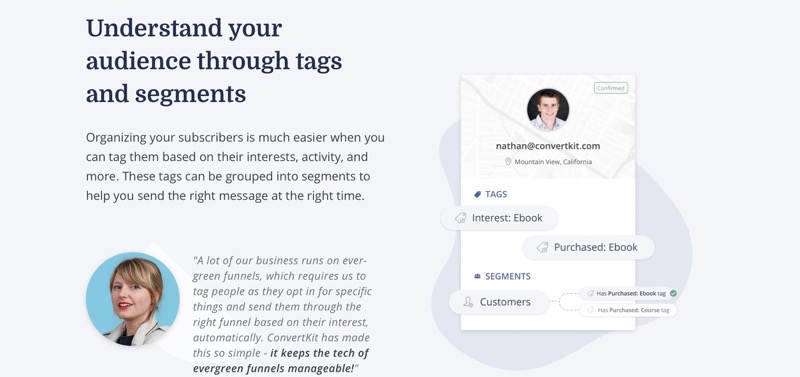

7. Sequences
ConvertKit allows you to create sequences that are basically a collection of different emails that are sent to your subscribers based on a predetermined schedule. Creating a sequence is fairly straightforward and simple with ConvertKit. It’s the same as building an email except you also have a menu on the left hand of the screen that allows you to create the sequence of emails that’ll be sent to your subscribers.
8. Automation
ConvertKit truly shines when it comes to its automation system. Considering the price point of ConvertKit, its automation system is simply unbeatable. It is very easy and simple to create automation on ConvertKit. What makes it even better is that ConvertKit comes with a lot of ready-made automation templates that you can use to get started quickly.
You can also find a visual automation editor that makes it really easy to understand the flow of your automation and allows you to map the journey of your subscribers with just a few clicks.
Without getting too much into it, there are basically four different ways a subscriber can enter the automation – via a form, by getting tagged, by a custom field, and by making a purchase. You can then control the automation using events, actions, and conditions.
Overall, out of all the features provided, ConvertKit’s automation is one of the most well-made ones as it allows you to create complicated sales journeys and funnels for your subscriber with an easy to use the visual editor.
9. A/B Testing and Analytics
When it comes to A/B testing, the options are very limited and simple on ConvertKit. You can only use A/B testing on the subject lines of your emails on ConvertKit. You can set up A/B testing by clicking the A/B button that’s located beside the subject line field on the email builder. While subject lines are arguably the most important part of your email and A/B testing them can help a lot in optimization, there’s a lot that can be improved.
As for analytics, you can get a quick view of all the important statistics for your campaigns. Important metrics such as open rate, subscribers, click rate, etc can be easily found. While ConvertKit provides basic analytics, if you want in-depth analytics you’ll have to use plugins as a workaround.
10. Integrations
While you might have heard that ConvertKit’s integrations are not really that extensive but in reality, there are a number of third party integrations available on ConvertKit. You can integrate ConvertKit with popular marketing tools such as Stripe, Shopify, Recart, Teachable, WebinarJam, WP Courseware, and more. In addition, you can use the Zapier plugin to access hundreds of more integrations.
Click Here To Try ConvertKit For FREE
ConvertKit Discount Code: Auto Applied
ConvertKit Features
Now that we’ve covered some of the core features of ConvertKit, let’s take a look at what makes ConvertKit really impressive. Other than being made for creators and being almost stupidly simple to use, here are some of the most impressive aspects of ConvertKit that I really like:
1. Visual Automation Editor
As mentioned above in this review, ConvertKit’s automation system is one of the most impressive features of the tool. While most email marketing tools force you to use complex automation editors which can be overwhelming for beginners, ConvertKit’s automation is simple and easy to use with the visual automation editor.
The visual automation editor is so easy to use that it is almost fun. You can seamlessly edit every single step in the visual automation editor. Everything can also be done within the automation editor itself which means you don’t have to go out of the editor to do things like editing the emails or forms that you’re using in your automation.
Overall, the visual editor definitely simplifies the automation process significantly and if you’re just starting out with email marketing, you’ll definitely appreciate the simplicity and power of the visual automation editor.
Click Here To Try ConvertKit For FREE
ConvertKit Discount Code: Auto Applied
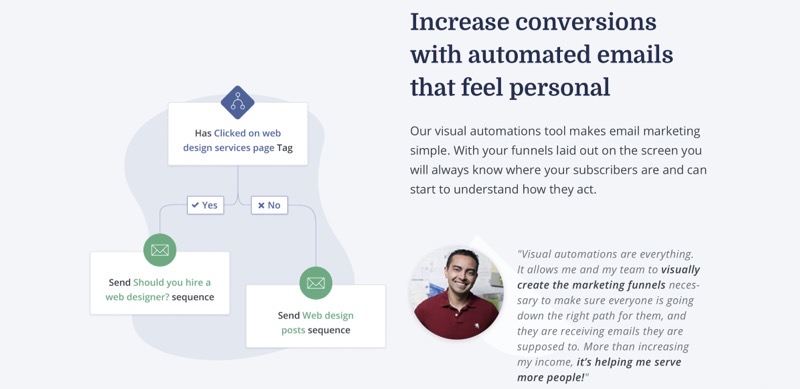

2. Conditional Tags
The ease of creating personalized emails is one of the key selling points of ConvertKit. Conditional tags are pretty useful when it comes to helping you a lot with personalization.
With conditional tags, you have the ability to ensure that only a particular segment of your subscribers will be able to read specific parts of the email.
For example, let’s say you want to send an email to all your subscribers but you want to include a discount code only for people who have made a previous purchase on your site. Instead of writing two different emails, you can just write one and use conditional tags so the discount code will only be shown to previous buyers.
To use conditional tags, all you have to do is click on the “personalize” tab found on the email builder and click on subscriber’s tags to set it up.
3. Resend Unopened Broadcasts
Marketing, especially email marketing, is generally a number’s game. It is a fact that a significant portion of your subscribers will not open all the emails you send them. In fact, only about 1 in 4 people will actually open an email you send them.
To save your time and make things simpler, ConvertKit allows you to resend the email to your subscribers who did not open it the first time. In addition, you can also experiment with a different subject line to try a different approach.
In order to resend the broadcast, all you have to do is go to the states page and click on the “Resend to Unopens” button and you’re done! Using this feature ensures that your emails get the maximum views and increases your chances of converting.
4. Share Automations
I already mentioned how great ConvertKit’s visual automation editor is but here’s another feature that I find really impressive – any visual automation that you make is also sharable. With just a few clicks, you can share the automation as a template with anyone!
The concept is similar to Clickfunnels’ sharing funnels feature as it allows you to collaborate with other people and share your process easily.
Additionally, if you share your automation with someone who doesn’t have a ConvertKit account, they will get a 14-day free trial and if they end up signing up for an account, you get an affiliate commission for it!
5. Double Opt-In
There’s a lot of discussion on the topic of single opt-ins vs double opt-ins. While double opt-ins act as an effective filter when it comes to the leads, the extra step can also hurt your conversion rate. In my opinion, both of them can be effective if used properly and you should definitely have the option of creating a double opt-in.
ConvertKit allows you to create a double opt-in if you’re using a lead magnet which is a pretty useful feature as lead magnets are definitely one of the best ways of growing your email lists.
Click Here To Try ConvertKit For FREE
ConvertKit Discount Code: Auto Applied
Convertkit Pros & Cons
- It has a simple, streamlined, and focused interface.
- It comes with a really awesome visual automation editor.
- It uses a tag-based approach to subscribers.
- Double opt-in for lead magnets.
- New features are added regularly.
- You can share your automations with others.
- It has a very easy process for creating personalized emails.
- Split testing available for email subject line only.
- Basic, text-based templates.
- Forms and landing pages are not highly customizable.
- Not suitable for medium to large companies.
Click Here To Try ConvertKit For FREE
ConvertKit Discount Code: Auto Applied
ConvertKit Customer Support and Community
ConvertKit has a decent customer support service. While they do not provide support over the phone, you can still get your issues resolved over email or live chat 24/7, all days of the year. The response time for email can take 2-3 hours but the live chat is pretty fast when it comes to responding to your issues.
You can also find a decent knowledge base with documentation and workshops that teach you how to use the tool to its maximum capacity.
As for the community, ConvertKit has a Facebook group called The ConvertKit Family. However, it is not really that huge and definitely not on the same level as the community behind tools like Clickfunnels. However, it is still a good place to discuss the features and functionalities of ConvertKit with other uses around the world.
ConvertKit Discount FAQs
How much does ConvertKit cost?
The ConvertKit pricing is super easy to understand: all the plans have almost the same features. The prices are based on the number of subscribers. ConvertKit has a free plan with unlimited landing pages and the paid plans start $29 a month for a maximum of 1,000 contacts, $49 per month for up to 3,000 subscribers or $79 monthly for a list of 5,000 contacts.
Does ConvertKit have a free plan?
Yes, the ConvertKit Free Plan allows you to build unlimited landing pages or opt-in forms to start growing your audience. However to send emails, you have to either upgrade to a paid account for $29/month OR if you invite a friend and unlock 100 subscribers.
Is ConvertKit Better Than MailChimp?
MailChimp is a list centric provider, while ConvertKit is subscriber centric. In my experience ConvertKit is miles ahead of anything MailChimp offers while being much cheaper. You can easily organize your subscribers with tags and segments.
Is ConvertKit Worth It?
The answer is definitely YES! If you are a professional blogger looking to take your email marketing to the next level ConvertKit is the best email marketing for you. Skip the MailChimp’s with their limited features and sign up for the tool the pros use.
ConvertKit might seem like a really basic tool at first but don’t let the simplicity misguide you. If you’re a content creator, it is easily the best email marketing tool that you can use. The pricing is very competitive and much better than other tools and you get a lot of powerful features with ConvertKit which means you get a ton of value for money.
The only reason why you shouldn’t be using ConvertKit is if you’re looking for really advanced and complicated automation but it is unlikely that most content creators looking to get started will need them. Overall, it is pretty hard to go wrong with ConvertKit.
I hoped you enjoyed my ConvertKit Review, let me know your thoughts below in the comments 🙂
Click Here To Try ConvertKit For FREE
ConvertKit Discount Code: Auto Applied
ConvertKit Alternatives
Now that we’ve covered almost everything you need to know, let’s take a look at how it compares against other email marketing tools like MailChimp, ActiveCampaign, and Aweber.
Convertkit Vs Aweber
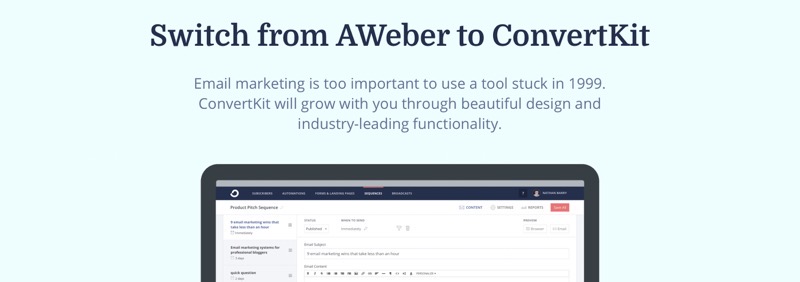

While Aweber is slightly cheaper than ConvertKit, there are a number of important features that Aweber is missing. Some of these features are split testing, double opt-in delivery feature, easily resending broadcasts to unopened emails. Automation is also much easier and better on ConvertKit than Aweber.
The only area where Aweber is actually better than ConvertKit is if you’re planning on a pure affiliate marketing strategy or CPA offers. Otherwise, in terms of features and design, ConvertKit is much better than Aweber.
Convertkit vs ActiveCampaign
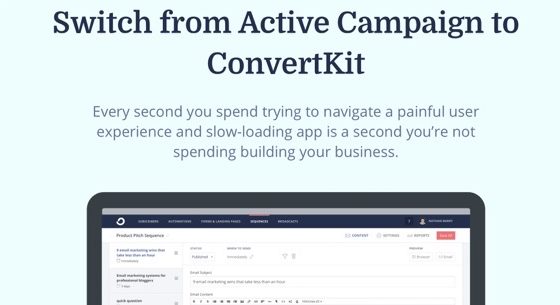

To be completely honest, ActiveCampaign is a really great email marketing tool and can be considered a serious alternative to ConvertKit. ActiveCampaign comes with a lot of powerful features like advanced automation and it is even better than ConvertKit in some aspects like split testing.
The pricing is also comparable between the two even though ActiveCampaign does get more expensive as you keep adding subscribers whereas the cost is much lower at higher subscriber levels with ConvertKit.
In the end, the choice between ActiveCampaign and ConvertKit boils down to what your specific needs are. If you’re just starting with email marketing and want a simple and powerful tool then ConvertKit is the perfect fit for you. However, if you want something more advanced and complex then ActiveCampaign might be a better option for you.
Convertkit vs Mailchimp
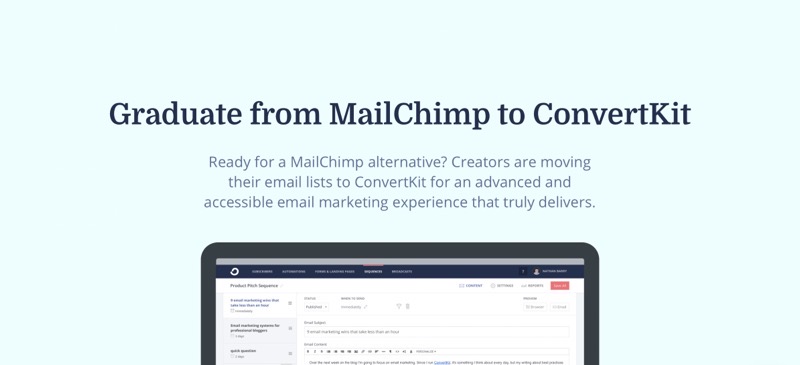

Email marketing is used by businesses all over the world when it comes to keeping their customers engaged and informed. In fact, email marketing is not only used by big businesses but also small e-commerce stores, entrepreneurs, content creators, and almost anyone with an online presence.
The reason why email marketing is still huge in 2021 is very simple – it is one of the best ways to reach your customers in a direct, personal way and the ROI it provides is simply unbeatable.
In this review, I’m going to compare two different email marketing tools. Both of them are pretty popular and have a huge number of users so it can be a bit hard choosing one of them over the other.
One of the tools is ConvertKit, which prides itself on being the best email marketing tool for content creators while the other is MailChimp, the most widely used email marketing tool in the world!
Click Here To Try ConvertKit For FREE


Before we start getting deeper into the differences between ConvertKit and MailChimp, let’s take a quick overview of the main differences between the two.
The first major difference between the two is that ConvertKit is a laser-focused email marketing tool while MailChimp has features that technically allow you to do more than just email marketing.
If you’re looking for a simple email marketing solution that just works, ConvertKit is the right choice for you. If you’re looking for a tool that offers more than email marketing features, MailChimp might be the right choice for you but there are better “all-in-one” marketing solutions out there.
Lastly, both of the tools come with a free plan that you can use to explore the features but once you upgrade to the paid plans, both of them charge premium prices.
About MailChimp
MailChimp is considered the industry standard for email marketing. Operating since 2001, there are few email marketing tools out there that can match up to its legacy. One of the major selling points for MailChimp is the free plan which is extremely generous and has helped them capture the market over the years.
However, being around for so long, some features of MailChimp are not as strong as the competition out there today. Even though it is still a solid email marketing tool and more, there are a lot of tools that perform just as good as MailChimp if not better.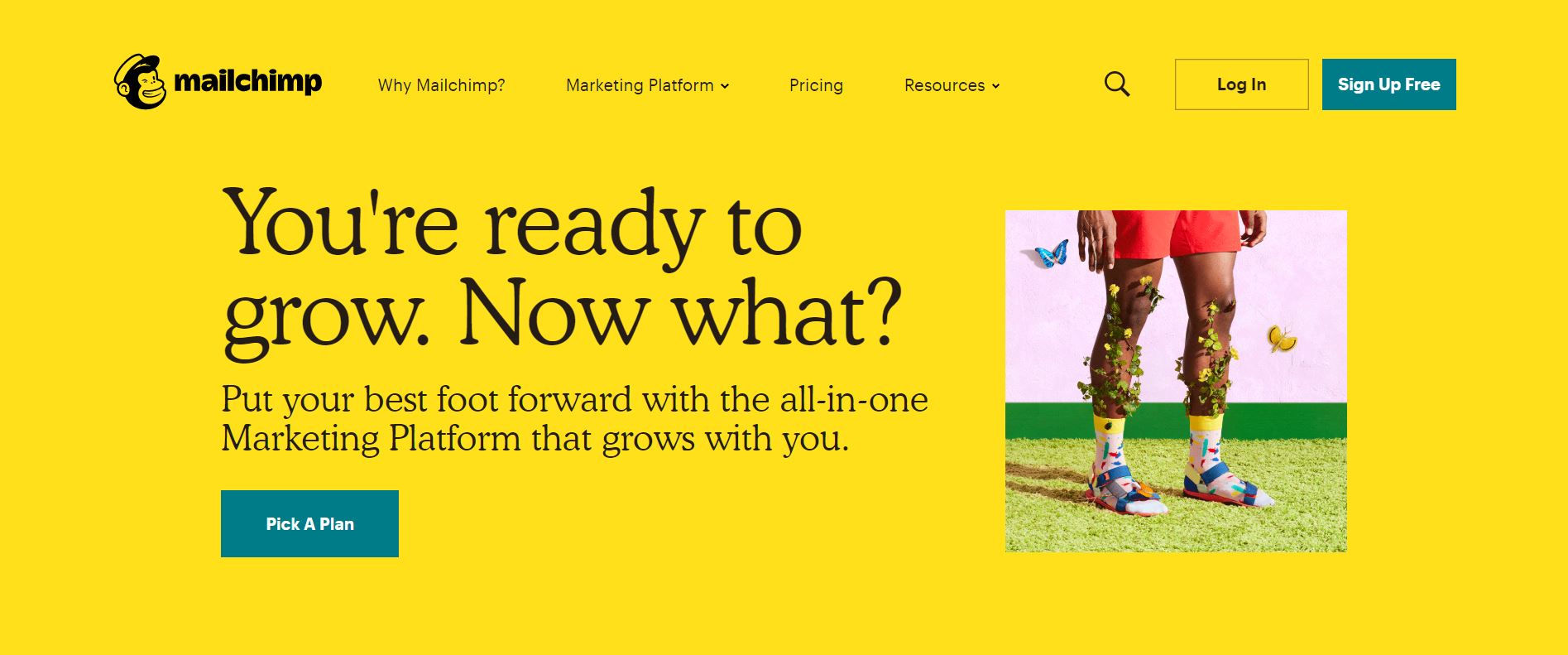

ConvertKit vs MailChimp: Ease of Use
Both ConvertKit and MailChimp are pretty easy to use but there are some subtle differences between the two tools.
MailChimp comes with an interface that is really easy to navigate. With MailChimp, you can either start creating and designing an email right away or go through the extra step of selecting the recipients before getting started.
The MailChimp editor is a drag-and-drop editor and you can quickly add or remove different elements from your email. However, for some people, the editor can seem a bit cluttered and overwhelming. I’ve covered the editor more in detail below in this review.
As for ConvertKit, the interface is also extremely easy to use. In order to get started with creating an email, you’ll have to go to the “Broadcasts” tab and click on the “New Broadcast” button. Once you’ve entered the recipients for the email, you can start designing your email right away!
ConvertKit’s editor, following its core philosophy of simplicity, is not a drag-and-drop but a text editor. It allows you to do basic things like managing the formatting, adding images, and so on. ConvertKit’s editor is designed so you focus on the content of the email rather than getting lost in the trivialities of the design.
Overall, both the tools rank well when it comes to ease-of-use and it would be unfair to say one of them is better than the other when it comes to that aspect. However, MailChimp can definitely work a bit on simplifying its interface.
Click Here To Try ConvertKit For FREE
ConvertKit vs MailChimp: Core Features
Now that we’ve covered the basic overview of the differences between ConvertKit and MailChimp, let’s take a deeper look at the features provided in both the tools.
ConvertKit comes with a lot of strong features, especially when it comes to list management and segmentation. However, some features like the email builder might leave a few people asking for more.
MailChimp also comes with a lot of features but there are definitely some features that are a bit outdated such as its list management and segmentation.
With that being said, let’s look at the different aspects of the two email marketing tools.
1. Sign-up forms
Sign up forms are one of the most important aspects of any email marketing tool and both ConvertKit and MailChimp allow you to build custom forms and landing pages for your email marketing campaigns.
To be honest, creating forms in ConvertKit used to be very annoying initially. For example, adding new fields was only possible by inserting custom code. However, with the new updates, ConvertKit now allows you to create forms using a visual editor that is super easy and convenient.
You can create three different types of forms on ConvertKit – embedded, slide-in, and pop-up. You can customize all the different aspects of the forms easily with the visual drag-and-drop editor. Some other cool things include the fact that you can decide how the form would appear to a user who has already signed-up using that form.
As for MailChimp, you also have the option of creating different kinds of forms such as pop-in and embedded. However, there is a slight issue when it comes to the form editor. The editor for embedded forms is actually different from the editor for pop-in forms.
The pop-in form editor is based on the drag-and-drop approach and is pretty easy to use but the editor for embedded forms is really confusing and very hard to use and it isn’t a drag-and-drop editor.
So, essentially, when it comes to creating sign-up forms, ConvertKit is much more simple to use and the experience is slightly better, easier, and quicker than building a sign-up form with MailChimp.
Click Here To Try ConvertKit For FREE



2. Landing pages
Landing pages are somewhat of a niche feature when it comes to email marketing tools but both ConvertKit and MailChimp allow you to create custom landing pages.
With ConvertKit, you get 4 ready-to-go templates that you can edit. The landing page editor is the same visual and drag-and-drop editor that you use for the forms.
When it comes to the customizing options available, ConvertKit is pretty limited but does allow you to use custom CSS which is a plus. The landing pages can then be hosted on your ConvertKit domain or your custom domains.
As for MailChimp, you have the option of choosing from 8 different templates. MailChimp also offers a lot more flexibility when it comes to customizing the landing page. The landing page editor in MailChimp is a lot better than the editor you’ll have to use for forms.
Both MailChimp and ConvertKit allow you to view statistics on the landing pages such as visits, clicks, and conversion rates. However, if you want to host the landing page on a custom domain using MailChimp, you’ll have to pay extra.
3. Email design and editor
When it comes to email design and editor, ConvertKit and MailChimp follow two completely different philosophies. Both of them make sense but it largely depends on the user and their intended goal.
ConvertKit’s philosophy is more suitable for content creators while MailChimp is much better if you’re either a large e-commerce company or business. Let’s take a look at why this is the case.
MailChimp offers a lot of templates that you can use to create emails. There are around 100 different templates offered for different purposes such as newsletters, promotions, holiday emails, etc. While some of these designs can seem to be a bit outdated, the sheer number of templates available is definitely something that comes in handy.
On the other hand, ConvertKit only offers three templates. All of them are very minimal and highly focused on the text. The three templates that are offered are pretty modern and responsive though.
As you can see, MailChimp’s philosophy for design is to go big and visual while ConvertKit’s philosophy is based around using the power of good content as their philosophy is based around the idea that the most important part of the email is the text itself.
As for the email editors, MailChimp comes with a full-fledged visual drag-and-drop editor that allows you to quickly create emails that are very impressive visually. ConvertKit, on the other hand, has a very basic email editor that is text-focused. You can change the font, colors, font-size, etc but it is still pretty basic.
By the way, ConvertKit is currently working on building a new editor that is visual and allows you to add custom HTML too so things might change in the future.
If you want to create loud design-intensive emails, MailChimp would be a far better option for you but if you’re a content creator and want your emails to be super focused on the text, ConvertKit would be a better option for your needs.
Click Here To Try ConvertKit For FREE


4. Managing contacts
One of the major differences between ConvertKit and MailChimp is how both the tools handle list management and segmentation.
Let’s start with ConvertKit. On ConvertKit, all your subscribers are stored in the same “list”. To organize them, you can assign different subscribers to different forms, sequences, or tags. You can also segment subscribers based on common characteristics regardless of which form, sequence, or tag they belong to. It is a pretty simple way to manage contacts and it works seamlessly.
As for MailChimp, you have the option of creating different lists to keep contacts segregated. However, if you want to add the same contact to different lists, you’ll be charged for every duplicated contact too. While you can also create segments within lists using fields or the “groups” features, MailChimp does not allow you to send broadcasts to two different groups at the same time.
Overall, ConvertKit comes with an easier and more straightforward approach to contact management while MailChimp’s contact management feature is pretty messy and complicated.
Also, since duplicate contacts in different lists are counted as separate contacts, it means that you end up paying for more contacts with MailChimp than the actual number of contacts you have which, in my opinion, is not fair.
5. Automations
Almost every major email marketing tool in 2021 offers some kind of marketing automation and both ConvertKit and MailChimp come with decent automation features. However, ConvertKit’s automation features are much better and modern when compared to MailChimp.
The automations in ConvertKit are handled by the “sequences” feature that allows you to build a series of emails that are sent automatically. One of the best things about ConvertKit’s automations is the visual editor which helps you plan and define your automations using a visual drag-and-drop editor!
ConvertKit’s visual automation editor allows you to create automation based on user actions, conditions, and events. It is also possible to add more than one sequence into a single automation. Other than that, you can also set up universal automation rules that allow you to do cool things like automatically change tags based on user behavior.
As for MailChimp, the automation system seems to still be stuck in the past. In the first place, finding the automation feature is not easy to find as it’s hidden in the “campaigns” menu. Additionally, there is no visual automation editor like you would find in ConvertKit. However, there are some things that MailChimp does well when it comes to automations like dealing with abandoned carts or webpage visits.
Overall, ConvertKit’s automation system is much easier to use and better than MailChimp’s automation system for most uses. MailChimp’s automation is pretty old-school and a major revamp is needed in my opinion.
Click Here To Try ConvertKit For FREE
6. Integrations
Integrations are very important for email marketing tools as they’re often used with different tools. Both ConvertKit and MailChimp allow you to integrate with a number of third party apps natively but MailChimp easily wins when it comes to integrations.
ConvertKit has around 90 different integrations that allow you to connect it to different applications and tools such as Wix, WordPress, Stripe, Shopify, and more. Additionally, it is also possible to integrate ConvertKit with Zapier that allows you to connect with more apps, even though it can be a bit more annoying than having native integrations.
As for MailChimp, the number of integrations provided is really large and it covers almost every major third-party tool that you’ll need to integrate with.
In terms of integrations, MailChimp definitely ranks better but it can be argued that it ranks better than any other email marketing tool in this aspect.
7. Reporting and Analytics
ConvertKit again takes a very simplistic approach to reporting and analytics. However, it can be argued that the approach is a bit too simple. With ConvertKit, you can access basic status such as click rates, open rates, unsubscribes, etc. However, that’s pretty much the full extent of it. It is not possible to get more detailed insights or data about your broadcasts and the reporting aspects of ConvertKit leave much to be desired.
MailChimp, on the other hand, almost goes overboard with the number of reports available. You can find all kinds of insights and data about your email marketing campaigns such as social stats, location-based data, click maps, sales, etc.
It also comes with some niche analytics features such as allowing you to compare the performance of your campaign against the industry average which can be pretty helpful.
Overall, when it comes to reporting and analytics, MailChimp is definitely a clear winner in terms of the features it provides. However, it can be a bit overwhelming if you’re just getting started with email marketing.
Click Here To Try ConvertKit For FREE


ConvertKit vs MailChimp: Customer Support
To be completely honest, you probably wouldn’t need a lot of customer support when it comes to using both ConvertKit or MailChimp but it is still good to know what both of them offer in terms of support.
You can get support via live chat and email on ConvertKit, regardless of the plan you’re on, from 8 AM to 8 PM EST every weekday. It is very easy to access customer support as you can find a sticky help button placed conveniently on the dashboard. With ConvertKit, you can get basic customer support even during the weekends via live chat or email.
ConvertKit also offers a pretty decent knowledge base that has tons of articles and guides to help you through basic issues.
MailChimp, on the other hand, offers a decent knowledge base too but the customer support provided on the tool is pretty bad in general. If you’re using the free plan, you have access to only the knowledge base. If you want email support, you’ll have to upgrade to a paid plan. If you want customer support over the phone, you’ll only get that with the most expensive plan on MailChimp.
Overall, in terms of customer support, ConvertKit performs much better than MailChimp as it offers decent customer support on all plans. Customer support is also easily accessible on ConvertKit while the same cannot be said about MailChimp.
Click Here To Try ConvertKit For FREE
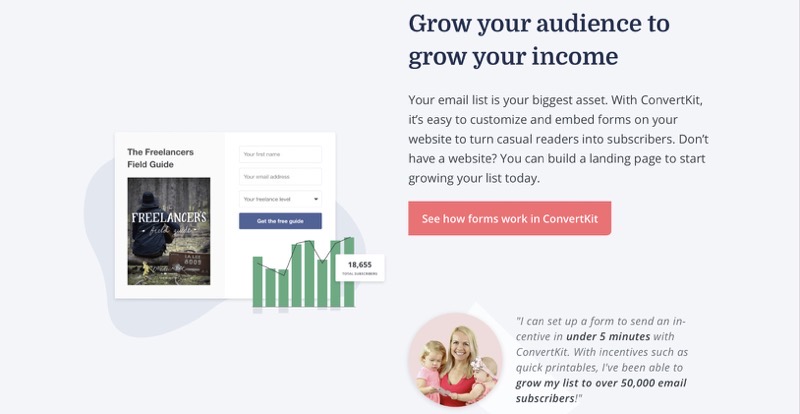

ConvertKit vs MailChimp: Pricing
Let’s get this clear from the start – both ConvertKit and MailChimp are not exactly cheap tools to use. In fact, when it comes to email marketing tools, both of them fall within the premium range. However, both of them also offer a free plan. Let’s take a look into the free plan offered by ConvertKit and MailChimp first:
| ConvertKit Free Plan | MailChimp Free Plan |
|
|
Overall, while both of the plans are pretty decent, MailChimp’s free plan has been its main draw for a long while. In fact, ConvertKit actually didn’t even offer a free plan until just recently in order to match up to MailChimp. Do note that MailChimp does block a lot of important features such as split testing, access to analytics, custom branding, etc with its free plan.
Now that we’ve covered the free plans, let’s take a look at the different paid plans available. On MailChimp, you can sign up for three different paid plans which are the following:


- Essentials ($9.99 per month to $259 per month for 500 to 50,000 contacts)
The Essentials plan has everything that’s included in the Free plan. Additionally, you get to use your own custom branding, split testing, access to all the email templates, and better support features. - Standard ($14.99 per month to $499 per month for 500 to 100,000 contacts)
The Standard plan comes with everything in the Essentials plan. Additionally, you also get access to advanced reporting and statistics, retargeting ads, custom templates, and advanced automation based on behavior. - Premium ($299 per month to $1,099 per month for 10,000 to 200,000 contacts)
Lastly, the Premium plan offers everything in the Standard plan. Additional features you unlock include advanced segmentation, customer support over the phone, advanced list management and segmentation, and multivariate testing.
Whereas MailChimp offers three different paid plans, ConvertKit only offers one single paid plan. Here’s a quick overview of the ConvertKit paid plan:
Complete ($29 per month to $3,999 per month for 1,000 to 900,000 subscribers)
The Complete plan offers all the features of the email marketing tool with nothing locked. You can manage up to 900,000 subscribers on this plan and have access to all the important features like visual automation, sequences, reporting, integrations, and API, etc.
Additionally, you also get access to premium customer support and free migration from any other email marketing tool that you might be using. Additionally, you can also get a 14-day free trial of the complete to get used to how it works.
As mentioned previously, both the services charge premium prices but in my opinion, ConvertKit’s approach to pricing is much better as there is only one paid plan and you don’t have to miss out on important features like split testing by using a lower-priced plan.
Click Here To Try ConvertKit For FREE
ConvertKit vs MailChimp: Conclusion
Now that we’ve covered everything that is relevant when it comes to ConvertKit vs MailChimp, here are my final thoughts on both the platforms.
While MailChimp has been in the limelight as the most widely-used email marketing tool for quite a while, tools like ConvertKit have challenged it over the years and proven to be excellent competitors.
There’s a lot that ConvertKit does better than MailChimp like automations, list management, and pricing. To be honest, if you fall within the target niche for ConvertKit i.e content creators, there’s probably no other better email marketing tool out there.
While MailChimp tries to do a lot of things at once and does some of them particularly good, it is not exactly the most user-friendly tool out there. This is especially important if you’re just starting out with email marketing and just want a simple tool that works.
Lastly, when it comes to pricing, it is true that both of them are premium options but in the long run, ConvertKit definitely delivers more value for money than MailChimp does. In general, if you’re not looking specifically for an e-commerce email marketing tool, I would suggest using ConvertKit over MailChimp any day!
Click Here To Try ConvertKit For FREE
Other deals:
Leave a Reply